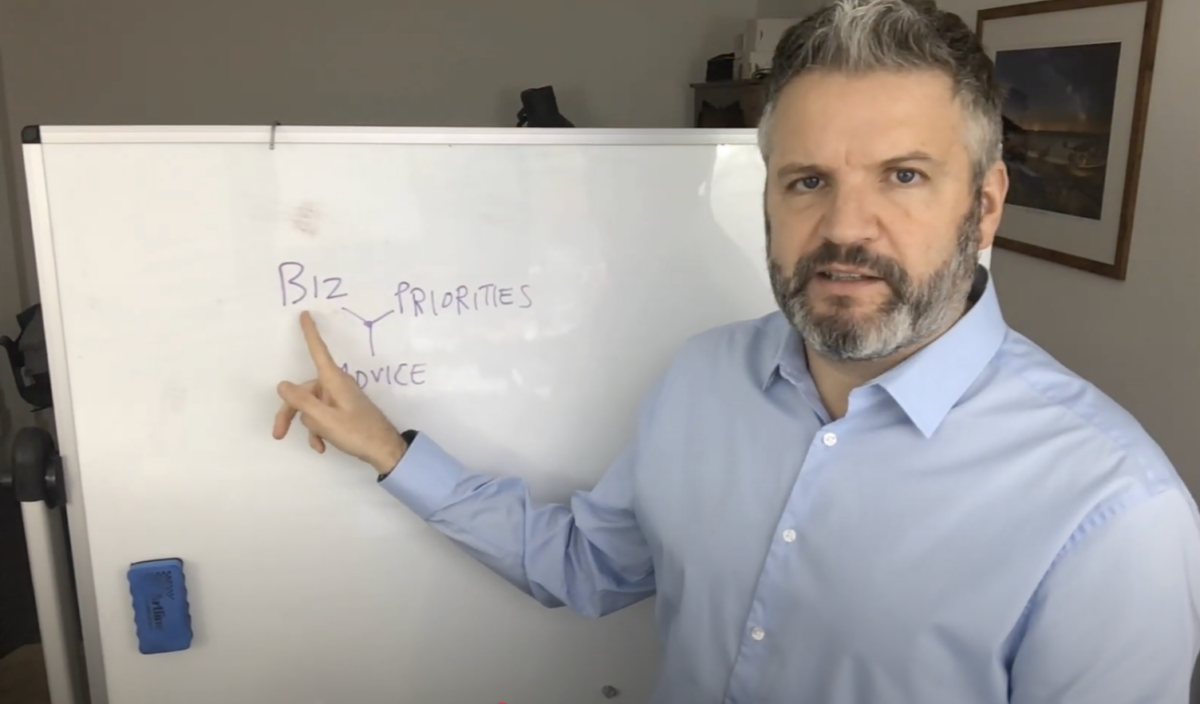Moving beyond dabbling with AI for personal productivity, how can Business Leaders, Entrepreneurs and Change Makers in organisations start building an AI strategy in 2025? This video covers why business leaders, in particular, are critical to AI success and how to identify potential AI projects that are uniquely specific to your business, the markets you operate and the challenges you face. Use AI itself to create a virtual AI consultant to develop ideas on your behalf, bespoke to your business.
Brief Video Summary
- Objective: to help business leaders, entrepreneurs, and change makers leverage AI for their organisations.
- The transformative potential of AI over the next five years, based on current capabilities rather than future advancements.
- The importance of leadership in AI adoption, including team engagement, good data, and a clear vision.
- AI thrives on context, and the exercise uses Chat GPT’s new projects feature as an example.
- Three key pieces of context are needed: business details (what it sells, its differentiation), current priorities (growth areas, competitive pressures), and the type of advice sought (low-hanging fruit, likely ROI, examples of successful implementations).
- The goal is to receive a short list of 5 to 10 specific AI ideas based on the business’s context and challenges.
Practical Steps for Creating a Virtual AI Strategist Using ChatGPT
- Create a dossier of relevant information on your business or area of responsibility. Include Business Information and pressing problems and priorities.
- Tell ChatGPT exactly the expertise you seek (Business language, practical not theoretical etc). Use the templates below if it helps.
- Create a Project in ChatGPT, add your dossier, and begin interrogating for the insights you seek. See this video from Open AI on how project folders work.
General tips
- Keep it conversational, use voice mode to answer the questions to help with free thinking and save time.
- Think about documents that are already sitting on your devices you can take advantage of.
- Don’t settle – if the results are uninspiring, too technical or based on futurist thinking rather than down-to-earth advice – let it know!
- Be as specific as possible when describing your business, priorities, and challenges. AI thrives on detail.
- Include relevant numbers or metrics where helpful (e.g., “Our churn rate is 15% annually”).
Templates – Build your own Virtual AI Strategist
Business Overview Questions
- What are your core products or services?
(Describe what your business sells and the primary value it provides to customers.) - Who are your target customers or key audience segments?
(Define the demographic, geographic, or psychographic details of your primary customers.) - What is your unique value proposition or differentiation in the market?
(Explain what sets your business apart from competitors and why customers choose you.) - What industry or sector do you operate in, and what are its major trends or challenges?
- (Provide context on your industry, including growth opportunities and competitive dynamics.)
- What are your current revenue streams, and how do they contribute to your overall business performance?
(Detail your income sources and their relative importance.) - What is the size and structure of your organisation?
(Include information about your team, such as the number of employees, key departments, or operational focus areas.) - How do you currently interact with and serve your customers?
(Describe your customer experience model, such as in-person, online, hybrid, etc.) - What are your primary operational processes, and where do you experience bottlenecks or inefficiencies?
- (Focus on areas that are resource-intensive, repetitive, or prone to errors.)
What role does technology currently play in your business operations?
(Explain the tools, platforms, or systems you currently use and their effectiveness.) - What metrics or KPIs do you use to measure success in your business?
(Identify key performance indicators, such as revenue growth, customer retention, or operational efficiency.)
With thorough answers, AI can offer highly relevant, actionable AI strategy advice tailored to the organisation’s specific needs.
Business Priorities Questions
- What are your top three strategic goals for the next 12 to 24 months?
(Examples: expanding into new markets, increasing customer retention, improving operational efficiency.) - Which areas of your business are experiencing the most growth or show the greatest potential?
(Focus on high-growth products, services, or customer segments.) - What are your biggest challenges or pain points currently holding back progress?
(Examples: supply chain issues, high churn rate, resource constraints, competitive pressures.) - What are your key performance indicators (KPIs) for success in the short and long term?
- (Metrics might include revenue targets, customer satisfaction scores, employee productivity, etc.)
- Where do you feel your business is falling behind competitors or market trends? (Identify areas such as innovation, customer experience, pricing, or technology adoption.)
- Are there specific operational inefficiencies or repetitive tasks that consume significant resources?
(Examples: manual data entry, slow customer onboarding, fragmented communication systems.) - What areas of your business do you believe could benefit most from innovation or technological improvement?
(Highlight departments, processes, or customer-facing activities.) - What new opportunities or emerging trends in your industry do you want to explore or capitalize on?
(For example, leveraging e-commerce, targeting Gen Z customers, or adopting sustainable practices.)
Note: You can ask generative AI to help you understand your priorities once it knows of your business, so that the priorities are aligned to your business rather than my generic list above.
AI Strategy Prompt for Business Leaders
We are looking for practical, actionable AI applications to explore in 2025. Our goals are:
- To identify the low-hanging fruit in our organization for AI adoption.
To understand the kind of ROI we can realistically expect from these applications. - To see case studies or real-life examples of organisations that have successfully implemented similar ideas.
In providing this advice:
- Focus only on real-life, currently available technology. Avoid speculative visions of what AI might do in the future.
- Avoid buzzwords or generic jargon. Provide clear, actionable intelligence about what steps to take next.
- For each idea, include at least one case study or example of a similar project executed successfully by another organisation.
For each example, detail:
- a. The likely technology or tools used to achieve the results.
- b. The preparatory steps the organisation needed to undertake before implementation.
- c. The type of data required to execute the project effectively.
We aim to create a short list of practical, high-impact AI initiatives tailored to our specific challenges and industry.
Examples of Specific Questions for Follow-Up
To dig deeper into specifics, consider these targeted prompts:
- “Based on our business model and industry, what are 3–5 high-impact AI applications we can implement with minimal disruption in 2025?”
- “Can you provide ROI estimates or measurable benefits seen by companies using similar AI technologies?”
- “For an AI-based [specific solution, e.g., recommendation system], what data would we need to gather, and how should we prepare it?”
- “What practical steps should we take to identify the right AI tools or platforms for our organisation?”
- “Can you compare examples of companies in [industry] that implemented [AI solution] and the results they achieved?”
Video Transcript – Create a Virtual AI Strategist with ChatGPT (2025 Guide for Business Leaders)
Introduction
In this video, I’ll explain how business leaders, entrepreneurs, and change-makers within an organisation can take advantage of AI in 2025 if you’re non-technical. Perhaps you’ve been using AI for your own personal productivity and are now wondering how you can really use it across your whole organisation to accelerate growth. If so, this is the video for you.
Why AI Matters Over the Next Five Years
Whilst there’s plenty of hype around AI at the moment, I genuinely feel that over the next five years, many businesses are going to be transformed by the use of AI. This prediction is not based on speculative technology of the future—it’s based on the AI we have right now. Regardless of any further advances, I think everything is going to be transformed over the next five years, so it’s an excellent time to explore new possibilities for your organisation and take advantage of what AI can offer.
The Importance of Leadership
Why must business leaders, entrepreneurs, and change-makers pay attention to AI? Well, AI is a technical field, but it also requires leadership. You need to bring your team and employees along with you, ensure you have good data, and maintain a clear vision. In short, you need leadership to guide AI initiatives to success.
Entrepreneurs, change makers, and business leaders have a crucial role in leading this change. The key question is how to move past the hype of what could happen in the future and start implementing AI in a practical way in 2025—so you can actually move the needle in your organisation.
Defining the Goal of This Video
The goal of this video is not to turn you into an AI expert, but to help you create a short list of low-hanging fruit that you can explore in your organisation. The focus is on specific applications of AI relevant to your business challenges, so you can begin exploring AI in 2025 even if you’re non-technical.
AI Thrives on Context
AI thrives on context. In this example, I’ll refer to ChatGPT’s newly released Projects feature, but you could just as easily use Google’s NotebookLM or something like Perplexity. The key is to provide three pieces of context for your AI queries:
- Information About Your Business
What do you sell? Who do you sell it to? Where is your value and differentiation? - Current Priorities
What is growing for you? Where are you feeling competitive pressure? Where is your industry going? - Desired Advice (in Business Language)
Where is the low-hanging fruit for your organisation? Where should you start with AI? What ROI might you expect? What examples exist of other organisations doing this successfully?
How to Provide the Right Information
For the business context, you might use the ‘About’ page of your website, or a pitch deck you present to new or existing customers. This typically includes your market, values, and unique selling points. You also need to think about your priorities: your commercial goals for next year, growth areas, potential for innovation, market trends, and so forth.
Finally, you want the advice to come in business-friendly terms rather than technical jargon. You’re aiming to generate a shortlist of five to ten ideas based on your specific business and challenges—areas of AI to explore in 2025.
Creating a ‘Dossier’ on Your Business
By compiling all this context, you build a dossier on your business that AI can really work with. If you ask generic questions, you’ll only get generic answers. But if you provide rich, specific information about your organisation, its direction, and the outcomes you’re aiming for, you can unlock powerful, targeted suggestions from AI.
Identifying Additional Opportunities
Another way to identify AI opportunities is to look at mundane or repetitive tasks your teams carry out. That can be valuable, but aligning AI with your overall business goals and priorities can have an even greater impact. By focusing on high-impact areas, you can achieve more transformational results.
Practical Tools and Templates
If you visit the blog post accompanying this video (linked in the comments), you’ll find templates for:
Structuring your business information
Describing your priorities
Outlining the advice you seek
Although I can’t provide your unique business details for you, these templates can guide the process and help you converse effectively with AI, generating tangible ideas to explore with your team or external consultants. This could include low-cost, high-impact AI initiatives to pursue in 2025.
Final Thoughts
Good luck with your AI journey. I hope these steps and insights help you move forward and take advantage of AI in 2025. Please let me know if you have any feedback about this process, and do share how you get on as you begin implementing AI in your organisation.

